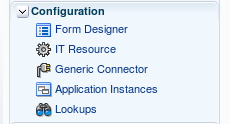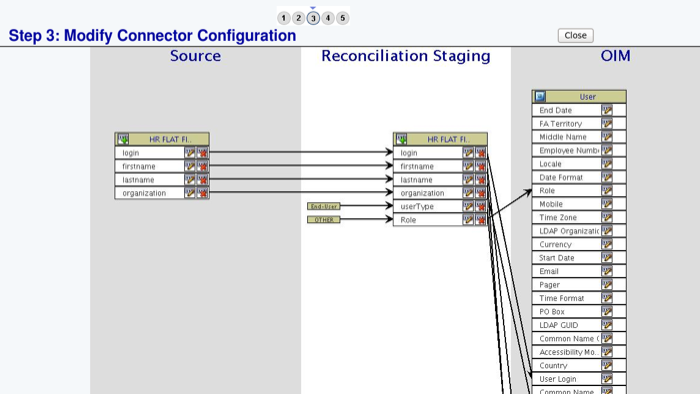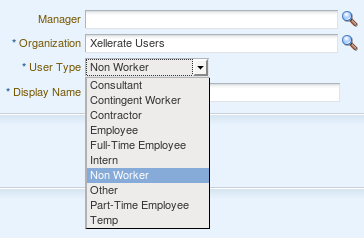With the intention to import many flat files in the future, I have created a stagingDR directory (with my initials included knowing that if I forget in the future, I know I created that) and within that directory I created another directory called Imports. This is where I will be dropping my data feed so OIM can acknowledge the file and import it.
Creating a home Directory
I created this within my OIM home directory (though I a live environment I would probably choose another location other then the OIM repository. If I type pwd it will show me that I'm starting within the /home/oracle/Oracle/Middleware/Oracle_IDM1/ directory.
Within a terminal window, I used the following command:
mkdir ./stagingDR
mkdir ./stagingDR/Imports
mkdir ./stagingDR/Complete
Then, create a new HR data feed to be imported within the stagingDR/Imports/ directory. called HRidentites.txt
vi ./stagingDR/Imports/HRidentites.txt
The identity feed used in this scenario are as follows:
#GTC Trusted Source
login|firstname|lastname|organization
DRedfern|Daniel|Redfern|Xellerate-Users
Understanding Mandatory fields
The only mandatory fields by default are as follows:
- Organization
- Last Name
- User Type

Once you've created the file, you're next task is to create the GTC connection which will be used within OIM to locate the file and import the users.
You need to go to the sysadmin URL (Mine is Http://localhost.localdomain:14000/sysadmin) and click on the generic Connection logo on the side. When a new window pops up, Click on Create to create a new GTC connection.
Specify the following Parameter Values Note: The directories may not match your environment so double-check the directory that matches the location on your environment Staging Directory: /home/oracle/Oracle/Middleware/Oracle_IDM1/stagingDR/Imports/
Archiving Directory: /home/oracle/Oracle/Middleware/Oracle_IDM1/stagingDR/Completed
File Prefix: HRidentites Specified Delimiter: |
Unique Attribute (Parent Data):login
File Encoding: UTF8
Click continue

You will be approached with a new screen showing the mapping of each attributes. You will notice in the middle (the Reconciliation staging area), that I included 2 new mandatory values. This is because these values are not include from the HR data.
UseType Attributes
For the userType attribute, there's options that you have. From a vanilla installation of OIM, the values you could use are as follows:
- Consultant = Consultant
- Contingent Worker = CWK
- Contractor = Contractor
- Employee = EMP
- Full-Time Employee = Full-Time
- Intern = Intern
- Non Worker = NONW
- Other = OTHER
- Part-Time Employee = Part-Time
- Temp = Temp

You need to map the attributes to the OIM side (right side).
I was failing to import the GTC data feed even though I clicked the 'matching only' tab when creating the trusted Reconciliation GTC. The video here also demonstrates how to complete the GTC flat file. You need to do the following effort from within the Design Console.
- 1. Click on the resource object
- 2. Click on the on the binoculars
- 3. Click on the Resource Objects Table
- 4. In the new tab, highlight the resource object the click back to the resource
- 5. Copy the Name of the Resource Object and then click on the Process Definition (located within the Process Management folder)
Design Console: Reconciliation Rule Builder
Open up a new window by clicking on the Reconciliation Rules (Located within the Development Tools).
Click on the Add Rule Element and add the following information:
- User Profile Data = User Login
- Operator = Equals
- Attribute = login
- Transform = None
You then need to go back to the Resource Object table to ensure the reconciliation profile is the latest version.
Click on The Resource Objects and search for the resource object like you did in the previous task.
Then click the object Reconciliation tab and then click Create Reconciliation Profile.
Now you should be ready to run the scheduling task as demonstrated from within the youtube video
ISSUE
<Dec 11, 2012 4:45:58 PM EST> <Error> <XELLERATE.GC.PROVIDER.RECONCILIATIONTRANSPORT> <BEA-000000> <Problem encountered in reconciling the first page of data com.thortech.xl.gc.exception.ReconciliationTransportException: No Parent files in staging directory or necassary access(READ) permissions are missing
SOLUTION
File doesn't exist
ISSUE: -cvc-minLength-valid: Value '' with length = '0'
Caused By: javax.xml.bind.UnmarshalException
- with linked exception:
[org.xml.sax.SAXParseException: cvc-minLength-valid: Value '' with length = '0' is not facet-valid with respect to minLength '1' for type 'matchingRuleType'.]
at javax.xml.bind.helpers.AbstractUnmarshallerImpl.createUnmarshalException(AbstractUnmarshallerImpl.java:315)
SOLUTION
Here is how you get around the issue...
Firstly, within the Design Console, you need to retrieve the resource object name (aka Object name) to then start building up a reconciliation rule. You do this by doing the following:- 1. Click on the resource object
- 2. Click on the on the binoculars
- 3. Click on the Resource Objects Table
- 4. In the new tab, highlight the resource object the click back to the resource
- 5. Copy the Name of the Resource Object and then click on the Process Definition (located within the Process Management folder)
About the author
 Daniel is a Technical Manager with over 10 years of consulting expertise in the Identity and Access Management space.
Daniel is a Technical Manager with over 10 years of consulting expertise in the Identity and Access Management space.Daniel has built from scratch this blog as well as technicalconfessions.com
Follow Daniel on twitter @nervouswiggles
Comments
Other Posts
AS I was migrating my environment into an S3 environment, I wanted to leverage off the SES services that AWS provide, more specifically, to leverage the off the SMTP functionality by sending an email via PHP
Read More...
The WeMos D1 is a ESP8266 WiFi based board is an extension to the current out-of-the-box library that comes with the Arduino installation. Because of this, you need to import in the libraries as well as acknowledging the specific board. This process is highly confusion with a number of different individuals talking about a number of different ways to integrate.
Read More...
NameID element must be present as part of the Subject in the Response message, please enable it in the IDP configuration.
Read More...
For what I see, there's not too many supportive documentations out there that will demonstrate how provision AD group membership with the ICF connector using OpenIDM. The use of the special ldapGroups attribute is not explained anywhere in the Integrators guides to to the date of this blog. This quick blog identifies the tasks required to provision AD group membership from OpenIDM to AD using the LDAP ICF connector. However this doesn't really explain what ldapGroups actually does and there's no real worked example of how to go from an Assignment to ldapGroups to an assigned group in AD. I wrote up a wiki article for my own reference: AD group memberships automatically to users This is just my view, others may disagree, but I think the implementation experience could be improved with some more documentation and a more detailed example here.
Read More...
In the past, the similar error occurred though for the Oracle Identity Management solution. invalidcredentialexception remote framework key is invalid Because they all share the ICF connector framework, the error/solution would be the same.
Read More...
org.forgerock.script.exception.ScriptCompilationException: missing ; before statement
Read More...
ForgeRock IDM - org.forgerock.script.exception.ScriptCompilationException: missing ; before statement
Read More...
When performing the attempt of a reconciliation from ForgeRock IDM to Active Directory, I would get the following error
Read More...
In the past, the similar error occurred though for the Oracle Identity Management solution. invalidcredentialexception remote framework key is invalid Because they all share the ICF connector framework, the error/solution would be the same.
Read More...
During the reconcilation from OpenIDM to the ICF google apps connector, the following error response would occur. ERROR Caused by com.google.api.client.auth.oauth2.TokenResponseException 400 Bad Request - invalid_grant
Read More...

